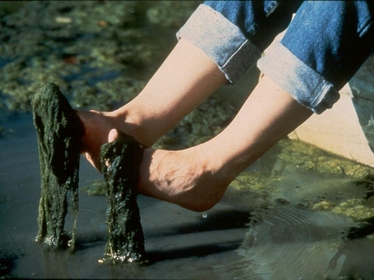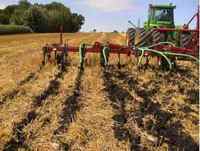
The Rock River Recovery is about EVERYONE in the Rock River Basin working together, as a team. Our Society. Our Waters. Our Industry, Cities, Farms, and Communities. The Rock River Recovery is a systematic approach to how we conduct our daily lives and balance these needs with our needs for reliable water supply and healthy lakes and rivers. It's about asking hard questions and finding common goals and solutions. The Rock River Recovery is not going to be easy, and it's not going to happen overnight. This is an honest "look in the mirror" to assess our waters, to best determine how we can all work together, and develop solutions to restore our impaired waters. The main tool we use to do this is the Rock River TMDL.
The Clean Water Act requires "Reasonable Assurance" that waste load allocations and load allocation in a TMDL will be implemented. WI DNR is committed to restoring water quality and designated uses in the Rock River Basin by developing and implementing a plan (separate from the TMDL Report) to accomplish the pollutant reductions identified in the Rock River TMDL document. In anticipation of the TMDL report completion, WI DNR created the Rock River Basin TMDL Implementation Team, composed of WI DNR and UW Extension staff, who have:
- Selected "Rock River Recovery" as the title of the implementation plan and related efforts.
- Held numerous working meetings to undertake the planning process and engage the public and volunteer stakeholders to participate in Sector Teams.
Successful implementation of the Clean Water Act and the Rock River Recovery (ultimately, this is the delisting of impaired waters) requires the direct involvement and activities of stakeholders throughout the entire Rock River Basin. To accomplish this goal, four public forums were held in 2011 and "Sector Teams" were developed with input from community members. Monthly updates from these sector teams are provided in the following section of this newsletter. If anyone is interested in participating in a Sector Team, they are invited to please contact the Sector Team Leader using the email hyperlink for each Sector Team.

Sector Team Mtg
We are currently planning the next Ag NPS Sector Team meeting to follow up on the quarterly forum in October. This will be a working meeting with an emphasis on finalizing NPS TMDL Implementation with county partners. While we are still finalizing speaker and venue arrangements, the agenda will include:
- Farmer Led Grant Opportunity
- County Template/STEPL Updates
- NPS TMDL Implementation Strategy discussion
P Reduction Wallet Cards
The Partnership for Ag Resource Management has developed the P-Loss Wallet Card to provide quick in-the-field reference for Soil Conservation practices that reduce P loss and soil erosion. Click Here to order
Events
There are a number of excellent opportunities for our agricultural partners in December. Check the links under the "Events" sidebar for more information on:
- UW Extension Nutrient Management Workshops
- UW Discovery Farms Conference
- Gypsum Additives to increase soil productivity
- Farm Estate Planning
|

While monitoring activities have quieted down with the onset of winter, the monitoring sector team efforts are continuing. DNR staff are working with partners to develop the monitoring section of the Rock River Recovery TMDL Implementation Plan. This collaborative efforts has taken longer than anticipated however, the draft of the plan is very nearly complete. We will be holding a sector team meeting in early 2016 to provide opportunities for review, participation and to solicit feedback for the final monitoring part of the implementation plan.
Grants
NOW is the time to start getting ready if you are interested or planning on applying for DNR Surface Water Grants. New guidelines have been developed for the DNR Surface Water Grant program in 2016. The first deadline - Lake Planning Grants, is December 10th! Contact your local Grants Specialist for more information - we're here to help you!
|

The Education and Outreach sector team has begun the process
of updating the Rock River Recovery Education and Outreach (E&O) plan. The
current version was completed in October of 2012 and with implementation plans
moving forward there is an opportunity to update the plan to reflect the
progress being made. The E&O sector team met November 16th to
begin to identify goals and objectives for the updated plan. The team will next
meet on December 16
to continue the review process (AGENDA).
The purpose of the E&O plan is to guide communication,
coordination and the implementation of educational efforts throughout the
basin. The DNR recognizes there are a number of organizations engaged in
educational efforts to improve water quality to meet the goals of the TMDL implementation
plan.
|

Road Salt
With the onset of winter and snow, it's important to be mindful of how we can minimize the impacts of road salt and deicers on our lakes and rivers. Indeed, a growing number of our waters are recognized as being impaired by chloride pollution and have been added to the 2016 Impaired Waters List. Check the following resources to learn more about how we can reduce these impairments:
Leaves
The Madison Area Municipal Stormwater Partnership wants to remind everyone it's not too late to take preventative actions to protect water quality and minimize stormwater runoff pollution to our lakes and rivers. MAMSWP has produced this brochure and educational video to provide examples of ways we can all do our part to protect water quality:
|

Sector Team
DNR Wastewater Staff have focused efforts in 2015 on drafting WPDES permits with TMDL limits and writing the wastewater section of the TMDL Implementation Plan. We are very pleased to announce the initial round of new permits has been completed for the basin with well over 1/2 of the permits reissued. We realize some of the new limits present real challenges to our communities and we are happy to work with you to find innovative solutions and provide ongoing support.
Additional efforts have focused on working with our customers to support efforts to use Adaptive Management and Water Quality Trading for permit compliance. We are planning another series of wastewater workshops for the Rock River community in 2016.
Statewide Multi-Discharger Phosphorous Variance
The WI Dept of Natural Resources is holding a Public Hearing on the proposed language with the statewide Multi-Discharger Phosphorus Variance on Dec 9, Wisconsin Dells.
Written comments also may be submitted by email or U.S. mail by Dec 16 2015:
DNRphosphorus@wisconsin.gov
Amanda Minks
DNR water resources management specialist
Wisconsin Department of Natural Resources
Box 7921
Madison, WI 53707-7921
US EPA Officially Approves first WPDES Permit to use Water Quality Trading
The US EPA has formally approved the first WPDES permit to take advantage of the Water Quality Trading option for permit compliance. This permit leverages nonpoint source conservation practices to offset waste load allocations. We'll have more information in the January newsletter.
|
|